
10 February 2025
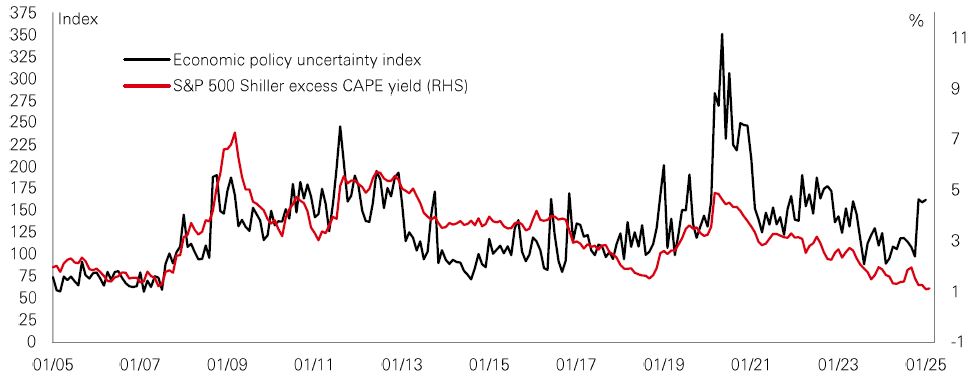
Quantitative measures of global policy uncertainty are increasing. Last week, like in the last few weeks, investors had to deal with another burst of episodic volatility in markets.
Global stocks weakened, reflecting how policy uncertainty can be a challenge to profits and how it prompts more risk aversion. While, in government bonds, there was a “flattening” of the yield curve (see further details on page 2), as markets reflected the possibility of bumpier disinflation.
Meanwhile, the US dollar remained a safe harbour, strengthening as policy uncertainty increased. But after being a serial winner in FX markets, investors are beginning to question whether “King dollar” can keep the crown? After all, the dollar is expensive, the Fed is still cutting rates in 2025, and US fiscal deficits are very wide. Investors need to consider the possibility that further dollar strength may be temporary.
Another telling sign of risk aversion in markets was the rally in the gold price. Gold has been on a tear over the past 12 months. The recent rise in policy uncertainty has seen that trend continue.
Overall, the latest bout of volatility – the third this year after the surge in bond yields and the AI trade wobble during January – reinforces that markets will face a volatile ride at times in 2025, albeit against a broadly constructive backdrop of no recession, further rate cuts and resilient profits. This is called “volatile Goldilocks”.
With bouts of volatility proving to be a feature of markets this year, diversification strategies are front of mind for asset allocators. After a strong performance in 2024, one asset class that could be ideally placed to keep delivering in these conditions is hedge funds.
Hedge funds have a track record of outperforming global balanced portfolios during spells of particularly high volatility. Moreover, when you combine them into well-diversified portfolios of different strategies, their own volatility profile compares well against traditional assets. In fact, with recent volatility notably affecting cryptocurrencies, hedge funds also offer potentially more resilience than non-traditional, crypto diversifiers.
Crucially, hedge fund strategies can profit from volatility in a range of ways, including long and short positioning, and arbitrage opportunities. Against a backdrop of higher levels of uncertainty, they have new opportunities to feed off the associated volatility. For 2025, rising uncertainty and market volatility are likely to play to the strengths of hedge funds, providing a potential boost to returns, as well as a degree of downside protection.
The value of investments and any income from them can go down as well as up and investors may not get back the amount originally invested. Past performance does not predict future returns. For informational purposes only and should not be construed as a recommendation to invest in the specific country, product, strategy, sector, or security. Any views expressed were held at the time of preparation and are subject to change without notice. Any forecast, projection or target where provided is indicative only and is not guaranteed in any way. Source: HSBC Asset Management. Macrobond, Bloomberg. Data as at 7.30am UK time 07 February 2025.
The yield curve has flattened by around 20bp since the US 10-year yield peaked in mid-January. However, some analysts continue to think the trend is towards a “structural steepening”. The prospect of further gradual Fed easing should put downward pressure on the two-year yield while further declines in the 10-year yield are likely to be limited by two key factors. First, US government debt is high and rising, and the situation is unlikely to change anytime soon. Second, a more fragmented geopolitical and international trade backdrop implies greater inflation volatility. The term premium on US Treasuries could, therefore, trend higher as investors require greater compensation for holding longer dated debt, leading to a gradual steepening of the curve. Moreover, should growth disappoint, and the Fed eases policy aggressively, the curve would steepen rapidly. |
Where this view could go wrong is if the Fed were forced to hike the funds rate. However, the bar for this to happen is quite high given Chair Powell views policy as “meaningfully restrictive” and the FOMC does not want labour markets to “cool off anymore”.
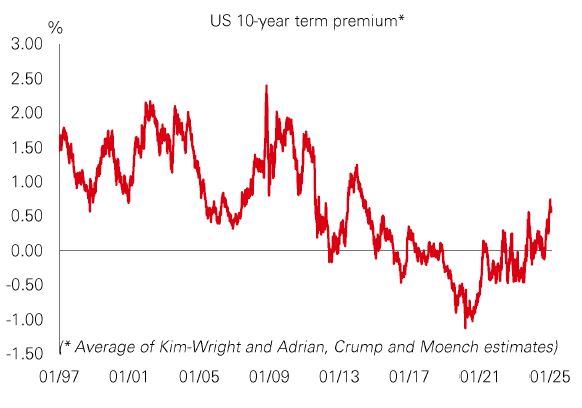
US earnings season approached half-way last week, with some of the S&P 500’s big technology names reporting figures for Q4 2024. After the recent ‘AI trade’ wobble, the outlook for tech profits has been under the microscope – particularly given the sector’s high valuations. Some ‘Magnificent Seven’ stock prices have been punished on marginal profit misses, high capex spending, and disappointing forward guidance. In terms of year-on-year Q4 profit growth, Financials are leading the index, with Communications Services and Technology also beating expectations. Among the growth laggards have been Industrials, Energy, and Materials. |
While the profits growth outlook is solid for the US, there have been downward revisions to 2025 consensus expectations recently. By contrast, Europe and China, which both saw a deterioration in the profit growth outlook last year, have seen revisions pick-up for 2025. This is evidence of profit growth potentially broadening beyond the US to markets that are significantly cheaper. In Europe, weak sentiment has set a low bar for positive surprises. While in China, further policy stimulus this year could herald a performance pick-up.
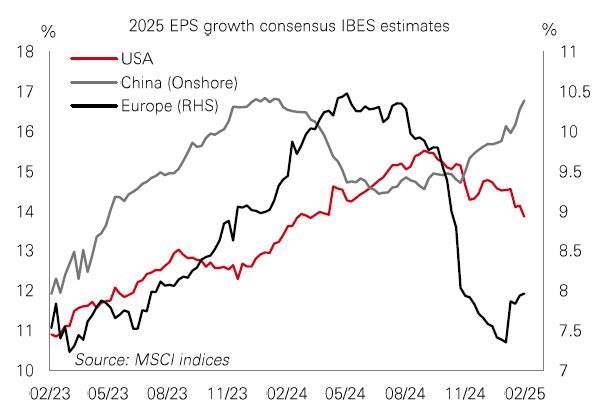
India’s recent FY2025-2026 Union Budget endeavoured to strike a balance between boosting growth, maintaining capex spending, and sticking to a path of fiscal restraint. India experienced a cyclical slowdown last year, so a key budget pivot was an income tax cut to encourage consumer spending. Meanwhile, capex spending on road and rail is set to remain flat, with marginal growth in other sectors. And as for the fiscal deficit, the reduction target for FY25-26 is 4.4% versus 4.8% in FY24-25. |
In response, consumer stocks rallied, while some railway, industrial and capex-sensitive plays corrected. Indian stocks have weakened since their peak last September, and CY24 earnings expectations have fallen by 3%. With an easing in frothy valuations, the large-cap Nifty 50 index now trades at a forward price-to-earnings ratio of 19.3x, which is around its five-year average. However, major sectors (excluding financials) are still trading at a premium and could be vulnerable to any macro or profit disappointments amid elevated short-term expectations. Active stock selection remains crucial.
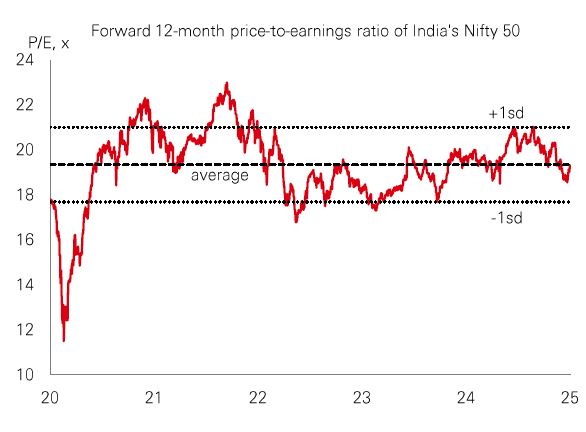
Past performance does not predict future returns. The level of yield is not guaranteed and may rise or fall in the future. For informational purposes only and should not be construed as a recommendation to invest in the specific country, product, strategy, sector, or security. Any views expressed were held at the time of preparation and are subject to change without notice. Any forecast, projection or target where provided is indicative only and is not guaranteed in any way. Index returns assume reinvestment of all distributions and do not reflect fees or expenses. Source: HSBC Asset Management. Macrobond, Bloomberg, Datastream. Data as at 7.30am UK time 07 February 2025.
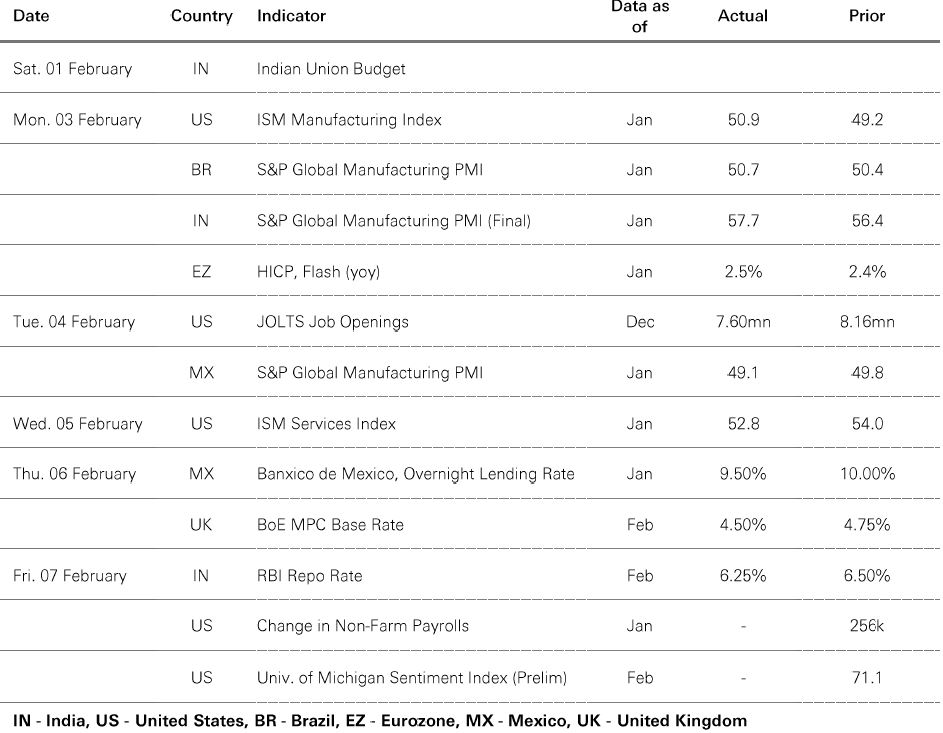
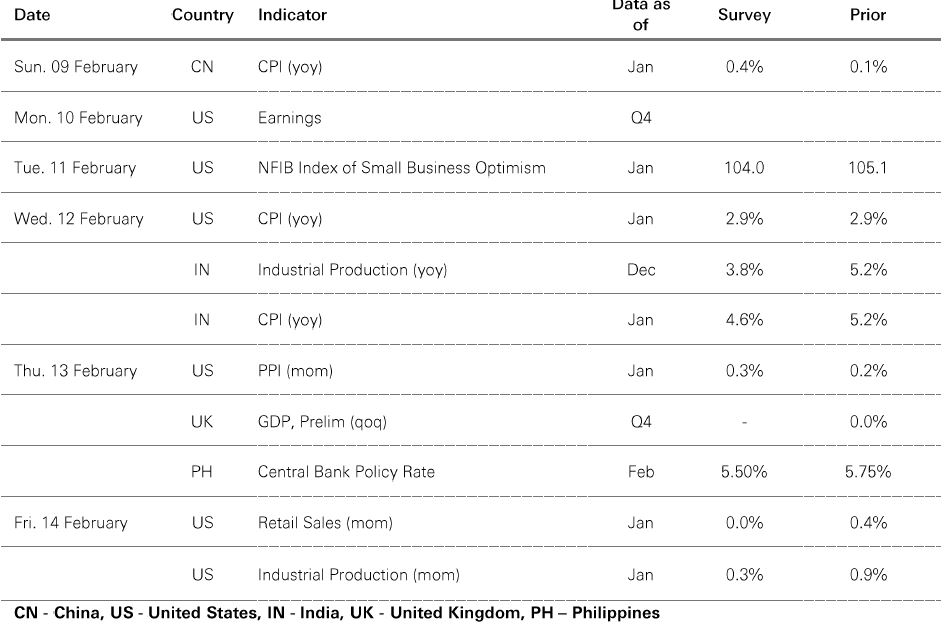
Source: HSBC Asset Management. Data as at 7.30am UK time 07 February 2025. For informational purposes only and should not be construed as a recommendation to invest in the specific country, product, strategy, sector or security. Any views expressed were held at the time of preparation and are subject to change without notice.
Rising global policy uncertainty cast a pall over risk markets last week. While the US dollar index consolidated, core government bonds rallied in response to some weaker-than-expected US macro prints, with eurozone bonds and UK Gilts slightly outperforming US Treasuries. The BoE lowered rates by 0.25%, with two members calling for a 0.50% reduction. In the stock markets, US equities reversed early losses last week, benefitting from lower US bond yields. The Euro Stoxx 50 index recorded stronger gains following a wave of upbeat earnings, while Japan’s Nikkei 225 ended lower amid investor caution over external uncertainties and a firmer yen against the US dollar. Other Asian stocks mostly performed well, with Hong Kong’s Hang Seng and mainland China’s Shanghai Composite posting catch-up rallies after the Lunar New Year holiday. In commodities, oil fell, whereas gold and copper both rose.






This document or video is prepared by The Hongkong and Shanghai Banking Corporation Limited (‘HBAP’), 1 Queen’s Road Central, Hong Kong. HBAP is incorporated in Hong Kong and is part of the HSBC Group. This document or video is distributed and/or made available, HSBC Bank (China) Company Limited, HSBC Bank (Singapore) Limited, HSBC Bank Middle East Limited (UAE), HSBC UK Bank Plc, HSBC Bank Malaysia Berhad (198401015221 (127776-V))/HSBC Amanah Malaysia Berhad (20080100642 1 (807705-X)), HSBC Bank (Taiwan) Limited, HSBC Bank plc, Jersey Branch, HSBC Bank plc, Guernsey Branch, HSBC Bank plc in the Isle of Man, HSBC Continental Europe, Greece, The Hongkong and Shanghai Banking Corporation Limited, India (HSBC India), HSBC Bank (Vietnam) Limited, PT Bank HSBC Indonesia (HBID), HSBC Bank (Uruguay) S.A. (HSBC Uruguay is authorised and oversought by Banco Central del Uruguay), HBAP Sri Lanka Branch, The Hongkong and Shanghai Banking Corporation Limited – Philippine Branch, HSBC Investment and Insurance Brokerage, Philippines Inc, and HSBC FinTech Services (Shanghai) Company Limited and HSBC Mexico, S.A. Multiple Banking Institution HSBC Financial Group (collectively, the “Distributors”) to their respective clients. This document or video is for general circulation and information purposes only.
The contents of this document or video may not be reproduced or further distributed to any person or entity, whether in whole or in part, for any purpose. This document or video must not be distributed in any jurisdiction where its distribution is unlawful. All non-authorised reproduction or use of this document or video will be the responsibility of the user and may lead to legal proceedings. The material contained in this document or video is for general information purposes only and does not constitute investment research or advice or a recommendation to buy or sell investments. Some of the statements contained in this document or video may be considered forward looking statements which provide current expectations or forecasts of future events. Such forward looking statements are not guarantees of future performance or events and involve risks and uncertainties. Actual results may differ materially from those described in such forward-looking statements as a result of various factors. HBAP and the Distributors do not undertake any obligation to update the forward-looking statements contained herein, or to update the reasons why actual results could differ from those projected in the forward-looking statements. This document or video has no contractual value and is not by any means intended as a solicitation, nor a recommendation for the purchase or sale of any financial instrument in any jurisdiction in which such an offer is not lawful. The views and opinions expressed are based on the HSBC Global Investment Committee at the time of preparation and are subject to change at any time. These views may not necessarily indicate HSBC Asset Management‘s current portfolios’ composition. Individual portfolios managed by HSBC Asset Management primarily reflect individual clients’ objectives, risk preferences, time horizon, and market liquidity.
The value of investments and the income from them can go down as well as up and investors may not get back the amount originally invested. Past performance contained in this document or video is not a reliable indicator of future performance whilst any forecasts, projections and simulations contained herein should not be relied upon as an indication of future results. Where overseas investments are held the rate of currency exchange may cause the value of such investments to go down as well as up. Investments in emerging markets are by their nature higher risk and potentially more volatile than those inherent in some established markets. Economies in emerging markets generally are heavily dependent upon international trade and, accordingly, have been and may continue to be affected adversely by trade barriers, exchange controls, managed adjustments in relative currency values and other protectionist measures imposed or negotiated by the countries with which they trade. These economies also have been and may continue to be affected adversely by economic conditions in the countries in which they trade. Investments are subject to market risks, read all investment related documents carefully.
This document or video provides a high-level overview of the recent economic environment and has been prepared for information purposes only. The views presented are those of HBAP and are based on HBAP’s global views and may not necessarily align with the Distributors’ local views. It has not been prepared in accordance with legal requirements designed to promote the independence of investment research and is not subject to any prohibition on dealing ahead of its dissemination. It is not intended to provide and should not be relied on for accounting, legal or tax advice. Before you make any investment decision, you may wish to consult an independent financial adviser. In the event that you choose not to seek advice from a financial adviser, you should carefully consider whether the investment product is suitable for you. You are advised to obtain appropriate professional advice where necessary.
The accuracy and/or completeness of any third-party information obtained from sources which we believe to be reliable might have not been independently verified, hence Customer must seek from several sources prior to making investment decision.
The following statement is only applicable to HSBC Mexico, S.A. Multiple Banking Institution HSBC Financial Group with regard to how the publication is distributed to its customers: This publication is distributed by Wealth Insights of HSBC México, and its objective is for informational purposes only and should not be interpreted as an offer or invitation to buy or sell any security related to financial instruments, investments or other financial product. This communication is not intended to contain an exhaustive description of the considerations that may be important in making a decision to make any change and/or modification to any product, and what is contained or reflected in this report does not constitute, and is not intended to constitute, nor should it be construed as advice, investment advice or a recommendation, offer or solicitation to buy or sell any service, product, security, merchandise, currency or any other asset.
Receiving parties should not consider this document as a substitute for their own judgment. The past performance of the securities or financial instruments mentioned herein is not necessarily indicative of future results. All information, as well as prices indicated, are subject to change without prior notice; Wealth Insights of HSBC Mexico is not obliged to update or keep it current or to give any notification in the event that the information presented here undergoes any update or change. The securities and investment products described herein may not be suitable for sale in all jurisdictions or may not be suitable for some categories of investors.
The information contained in this communication is derived from a variety of sources deemed reliable; however, its accuracy or completeness cannot be guaranteed. HSBC México will not be responsible for any loss or damage of any kind that may arise from transmission errors, inaccuracies, omissions, changes in market factors or conditions, or any other circumstance beyond the control of HSBC. Different HSBC legal entities may carry out distribution of Wealth Insights internationally in accordance with local regulatory requirements.
Important Information about the Hongkong and Shanghai Banking Corporation Limited, India (“HSBC India”)
HSBC India is a branch of The Hongkong and Shanghai Banking Corporation Limited. HSBC India is a distributor of mutual funds and referrer of investment products from third party entities registered and regulated in India. HSBC India does not distribute investment products to those persons who are either the citizens or residents of United States of America (USA), Canada or New Zealand or any other jurisdiction where such distribution would be contrary to law or regulation.
The following statement is only applicable to HSBC Bank (Taiwan) Limited with regard to how the publication is distributed to its customers: HSBC Bank (Taiwan) Limited (“the Bank”) shall fulfill the fiduciary duty act as a reasonable person once in exercising offering/conducting ordinary care in offering trust services/ business. However, the Bank disclaims any guarantee on the management or operation performance of the trust business.
The following statement is only applicable to PT Bank HSBC Indonesia (“HBID”): PT Bank HSBC Indonesia (“HBID”) is licensed and supervised by Indonesia Financial Services Authority (“OJK”). Customer must understand that historical performance does not guarantee future performance. Investment product that are offered in HBID is third party products, HBID is a selling agent for third party product such as Mutual Fund and Bonds. HBID and HSBC Group (HSBC Holdings Plc and its subsidiaries and associates company or any of its branches) does not guarantee the underlying investment, principal or return on customer investment. Investment in Mutual Funds and Bonds is not covered by the deposit insurance program of the Indonesian Deposit Insurance Corporation (LPS).
Important information on ESG and sustainable investing
Today we finance a number of industries that significantly contribute to greenhouse gas emissions. We have a strategy to help our customers to reduce their emissions and to reduce our own. For more information visit www.hsbc.com/sustainability.
In broad terms “ESG and sustainable investing” products include investment approaches or instruments which consider environmental, social, governance and/or other sustainability factors to varying degrees. Certain instruments we classify as sustainable may be in the process of changing to deliver sustainability outcomes. There is no guarantee that ESG and Sustainable investing products will produce returns similar to those which don’t consider these factors. ESG and Sustainable investing products may diverge from traditional market benchmarks. In addition, there is no standard definition of, or measurement criteria for, ESG and Sustainable investing or the impact of ESG and Sustainable investing products. ESG and Sustainable investing and related impact measurement criteria are (a) highly subjective and (b) may vary significantly across and within sectors.
HSBC may rely on measurement criteria devised and reported by third party providers or issuers. HSBC does not always conduct its own specific due diligence in relation to measurement criteria. There is no guarantee: (a) that the nature of the ESG / sustainability impact or measurement criteria of an investment will be aligned with any particular investor’s sustainability goals; or (b) that the stated level or target level of ESG / sustainability impact will be achieved. ESG and Sustainable investing is an evolving area and new regulations are being developed which will affect how investments can be categorised or labelled. An investment which is considered to fulfil sustainable criteria today may not meet those criteria at some point in the future.
THE CONTENTS OF THIS DOCUMENT OR VIDEO HAVE NOT BEEN REVIEWED BY ANY REGULATORY AUTHORITY IN HONG KONG OR ANY OTHER JURISDICTION. YOU ARE ADVISED TO EXERCISE CAUTION IN RELATION TO THE INVESTMENT AND THIS DOCUMENT OR VIDEO. IF YOU ARE IN DOUBT ABOUT ANY OF THE CONTENTS OF THIS DOCUMENT OR VIDEO, YOU SHOULD OBTAIN INDEPENDENT PROFESSIONAL ADVICE.
© Copyright 2025. The Hongkong and Shanghai Banking Corporation Limited, ALL RIGHTS RESERVED.
No part of this document or video may be reproduced, stored in a retrieval system, or transmitted, on any form or by any means, electronic, mechanical, photocopying, recording or otherwise, without the prior written permission of The Hongkong and Shanghai Banking Corporation Limited.